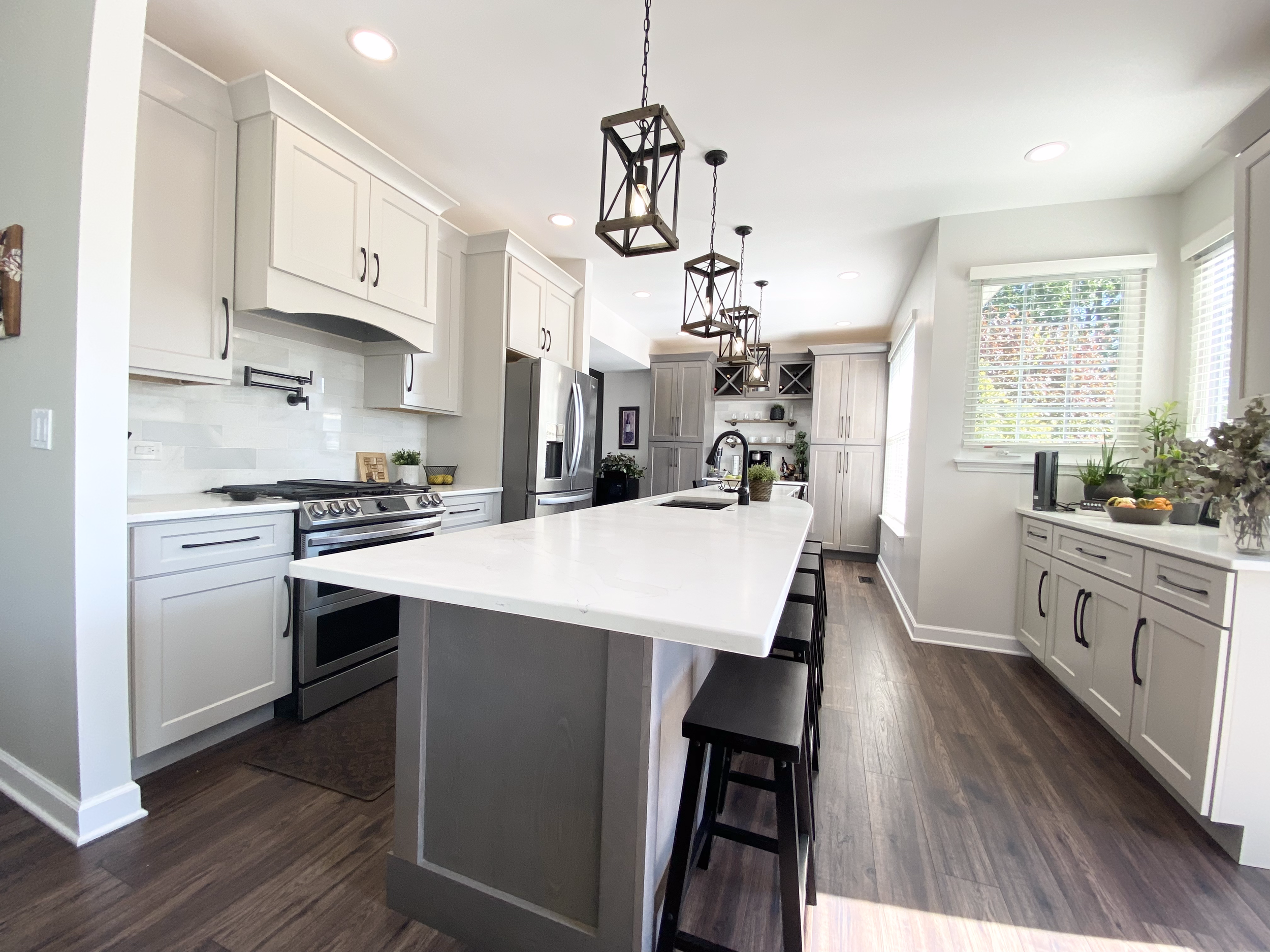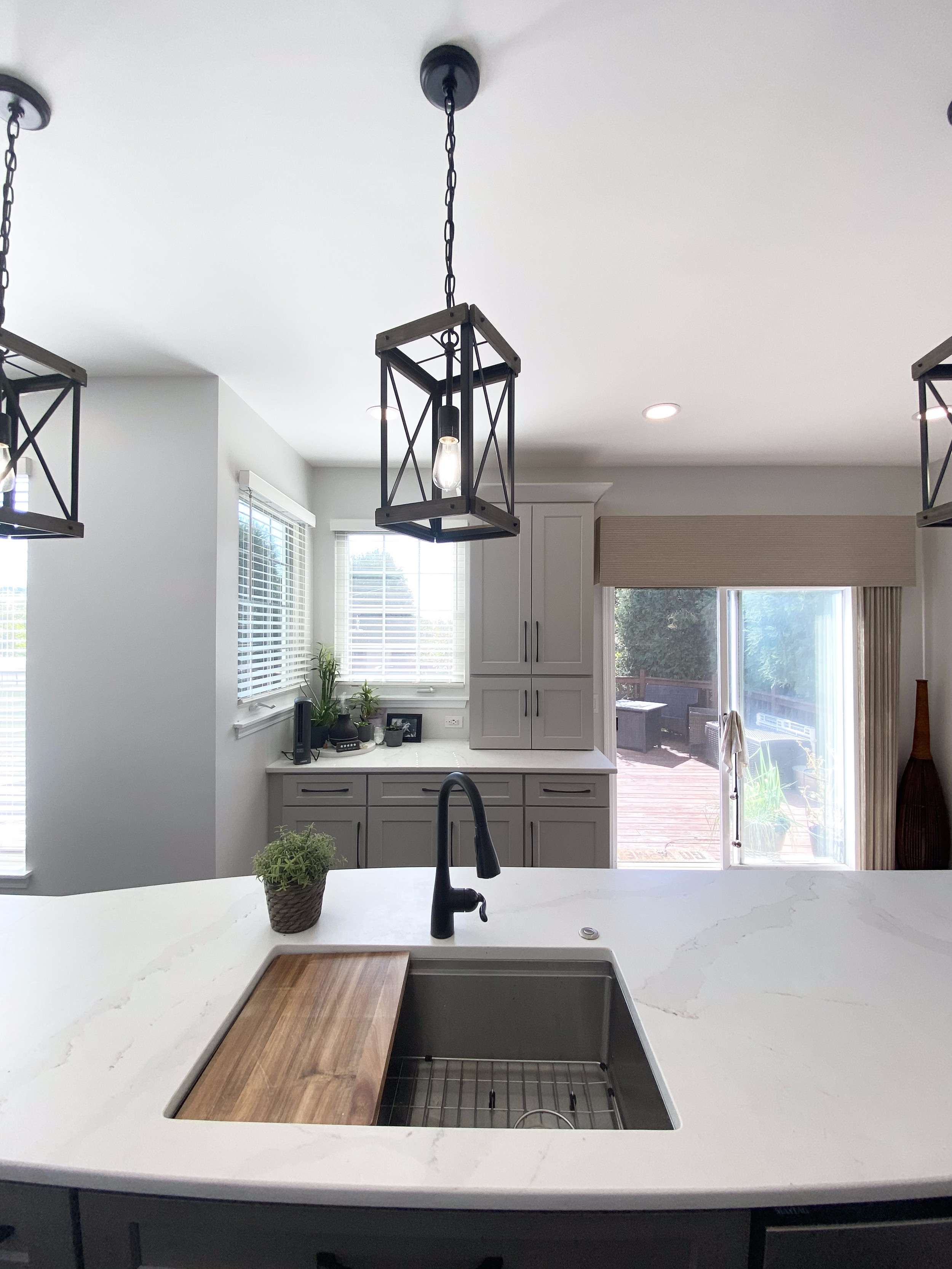Guide & Tips For Picking Your Perfect Kitchen Cabinet
The Lotus Home Improvement stunning Lindenhurst kitchen remodel features Legend Cabinets, QuickStyle luxury laminate flooring, matte quartz countertops throughout, a marble backsplash, and many custom upgrades such as a pot-filler, two custom pantries with pull-outs, an appliance cabinet station, and much more!
“Are you dreaming of that Pinterest-perfect kitchen remodel upgrade?”
Whether you decide to do a complete kitchen renovation gut job overhaul or go with some minor upgrades, selecting the right kitchen cabinet can make or break your entire kitchen design look! The kitchen is one of the first rooms potential buyers and your guests will see, so you’ll want to ensure your kitchen cabinetry is both looking and functioning their best. To help you out, I’ve come up with the most important tips for choosing the perfect cabinet, to reflect your personal style and also compliment your kitchen. Come on and dive in for more!
START WITH YOUR BUDGET
Yep, those Pinterest and Houzz photos sure are amazing! Especially after all the lighting enhancements and well-placed bowls of fruit and hand towels that really make those cabinets pop. If you have the budget to go along with it… Splurge! Otherwise, come on back down to reality with the rest of us and do some research on how much a kitchen renovation costs.
HOW DO I DETERMINE HOW MUCH CABINETS WILL COST?
A wood hood with pot-filler highlights this area to perfection! The crown molding and marble backsplash add to kitchen design.
Determining the cost depends on a wide range of factors but the best place to start is by establishing a budget for your new or renovated kitchen. There are some general guidelines for budgeting items like cupboards, countertops, and appliances so by starting with a budget, you'll be able to zero in on what you should expect to spend on cabinets.
Industry statistics show that on average, cabinets make up approximately 40-50% of the kitchen budget which is also the largest percentage of overall expenditures for the kitchen. Using this as a guideline you'll be able to determine what your allowance should be. There's nothing holding you back from spending more or less but this just means that the other parts of your kitchen will make up correspondingly higher or lower percentages of the overall budget. So, if your kitchen remodeling budget is $60,000, expect to pay roughly $22K-30,000 for cabinets. Again, this assumes average statistics.
Once you have an idea of what you're willing to spend, you'll be better equipped to make choices on the wide range of options available to you.
Cabinets are priced based on how many you buy and quantity of bells and whistles that they incorporate. Options and upgrades abound and they increase the price. These options include everything from the materials used to construct them to the range of finishes to the organizing gadgets that go inside them. The key is to prioritize what it is you really want/need by asking and answering some questions and making sure those 'must-haves' fit into your budget.
DETERMINE YOUR KITCHEN REMODELING GOALS
Pin down your goals for how you want your kitchen to look and function so that you're ultimately satisfied with the end result. You should do this regardless of whether you're replacing your existing cabinetry (staying with the same layout) or starting with a completely new layout plan.
Here are some questions:
Here is the before kitchen space of the Lindenhurst kitchen remodel featured. Our client loved to entertain and cook. Their original space was cramped and dated. We suggested reconfiguring the layout and removing the wall between the wall between the dining room and kitchen. We also removed the existing builder grade pantry and put in two custom cabinet pantries along the back wall. We used our Legend cabinet line.
What don't you like about your current cabinets?
Pin down exactly what it is you dislike so that you can look for solutions to those issues when it's time to buy new. Look at both function and style - this is where it is a great idea to bring along those photos to your kitchen designer and go through the things you like and don’t like.
The more specific you can be about what it is you want to have or change, the more focused you'll be about targeting the right options from the myriad of choices that are available.
How long do you plan on staying in your home - are you updating for the purpose of reselling or do you plan on staying long term?
The answer to this question may determine the price you're willing to pay as well as the level of customization, uniqueness and the quality of construction you want to build in. If you plan to stay in your current home indefinitely, you may want to spend more of your budget on durable construction and materials. On the other hand, if you're looking for a quick resale, you may want to limit your investment to a functional but more cost-effective cabinet style and construction.
What is the style of your home and your kitchen?
Your existing decor and style of the home play a role in the type of cabinetry to choose. The converse is also true too -- the style you choose will influence the look and feel of your kitchen.
Do you want to stay with the existing style or do you want to change it?
Regardless of which way you go, identifying the style you're looking for will help narrow your focus on the available choices and also provide some guidance to kitchen designers or cabinet dealer/makers you choose to work with.
Cabinet Door Style Glossary
There are dozens of different cabinet styles, but choosing a construction and door type will help narrow the options. I tend to prefer modern to transitional cabinet styles. Transitional cabinets, like a transitional kitchen, are considered a blend of traditional and contemporary styles.
Depending on the architectural style of the home and taste preferences of my clients, I typically will select from slab, flat panel, shaker, raised panel, or beaded door styles. Other popular styles include glass inset, mission, and arched cathedral.
Arched cathedral: The door panel is shaped like an arched window. The shape can be recessed or raised within the door frame. This style is typically reserved for upper wall cabinets.
Beaded: The interior panel features stripes created by a single or double groove (these are known as beads in woodworking). Beaded panels can be combined with other styles.
Flat panel: Exactly what it sounds like—the door has a single flat panel surrounded by molding. It’s the preferred style for transitional kitchens.
Glass inset: The doors are essentially windows into the cabinet. Not recommended for the unorganized.
Mission: Mission cabinets are a type of flat panel doors. They have a square frame molding with simple, clean lines. They are typically made of oak and stained so the wood grain is highlighted.
Raised panel: Cabinets with raised panel doors are more traditional in style. The center panel is slightly raised by a contoured groove around the molding.
Shaker: These look similar to mission cabinets, but they have a narrower frame molding. The focus is on function and durability.
Slab: The most minimalist of options, slab cabinets feature no panels, molding, or ornamentation. They can have hardware pulls, but the ultimate minimalist will opt for a finger ledge or push-to-open mechanism to eliminate hardware altogether.
RTA, Stock, Semi-Custom, and Custom
One area that tends to get misunderstood involves the terms RTA, stock, semi-custom, and custom. Contrary to what many people think, these terms are not related to the quality of cabinets but rather, how they're manufactured. Here are the basic definitions:
Ready-to-assemble (RTA) cabinets are found at big-box retailers like Ikea. RTA cabinets can save you money, but they will be less durable. Building and installing cabinetry isn’t as simple as building a shelf or bed, so even skilled DIYers may need to hire professionals for the installation.
Stock - Stock cabinets are pre-manufactured in specific sizes, typically 3" increments, with few if any options for customization other than some limited choices the manufacturer might offer. They are off-the-shelf products in a limited range of styles.
Semi-Custom - Semi-custom units are like stock in that they're also pre-manufactured but come with a wider array of options and in more sizes than pure stock cabinets. With semi-custom, you have some ability to pick and choose various details to tailor an otherwise pre-built stock product. In other words, you have some customization choices.
Custom - Custom cabinets are built to the customer's specifications, with no limitation on size, style choices, wood grade, or finish. They are truly made-to-order.
They may be fancy or they may be plain but the difference is that they're made to suit your specific design requirements, in whatever size, form, color, and material you can get someone to produce for you.
Materials - they include particleboard, MDF (medium-density fiberboard), plywood, solid wood, metal, and laminate/melamine (the laminate or melamine is laid over the particleboard or similar substrate).
Construction and Design - cabinets are constructed in one of two different design styles -- framed or frameless. Framed cabinets employ a wood frame that outlines the front of the cabinet box. Frameless units don't have this feature. Also, the joinery and techniques used to assemble and support them. Structural braces are made from plastic, wood, or metal. Methods of joinery include hot glue, staples, and nails, or, more intricate woodworking techniques like dovetails and dadoes.
Hardware - drawer slides vary in level of quality (some use ball bearings whereas others use nylon wheels/rollers) and physical location on the drawer (side-mount or on the bottom) which affects available drawer space. Shelf mounting brackets can be either plastic or metal.
CHOOSE THE CONSTRUCTION
There are two types of cabinet construction. Framed cabinets have rails and stiles that form a 1.5-inch face frame at the front of the cabinet box that is attached to the door front to give extra strength and dimension to the finished cabinet. With this construction, you have more flexibility with door types; it allows for standard, full overlay, and inset cabinet doors (more on door types below).
Frameless construction is a European method of manufacturing cabinets that has become increasingly popular with American homeowners. It offers a more contemporary look and better interior access by excluding the face frame, relying on denser box construction for stability. ing on denser box construction for stability.
DIFFERENT WAYS TO BUY
There's really no limitation on where you can buy cabinets. You can purchase them from big-box home centers, lumberyards, local cabinet makers, kitchen design firms and you can even buy them online.
Buying through the internet has grown over the years and there are now plenty of online retailers to choose from. In most cases, they offer lower costs for similar or even better quality than those you buy in home centers (many online cabinet retailers sell all-wood products).
Buying online also offers convenience because you make your choices on your own schedule, from the convenience of your computer. Bear in mind however that there are some differences between buying cabinets online and buying them at a home center, so it helps to learn about the process beforehand to determine if it's right for you.
The problem with buying online is undoubtedly understanding and properly doing measurements. Kitchen cabinets come in specific sizes. If the measurements are off by even 2”, the entire layout will not work and will be your responsibility. Preparing the measurements of your space and ultimate design is very important.
Lotus Home Improvement is an online cabinet dealer with a twist! We offer the pricing and quality of an online cabinet dealer - bringing the showroom to our north Chicago suburban customers. We provide complementarity measurement and design services.
Camille Johnson: Sales & Marketing
Camille Johnson does all things Marketing for Lotus. She loves home design, beauty tips & tricks, dreaming up biz/marketing ideas, vegetarian cooking, meditation, & traveling to beach destinations with her hubs — but not necessarily always in that order. ;)
FOLLOW CAMILLE: (on lotus lane)








